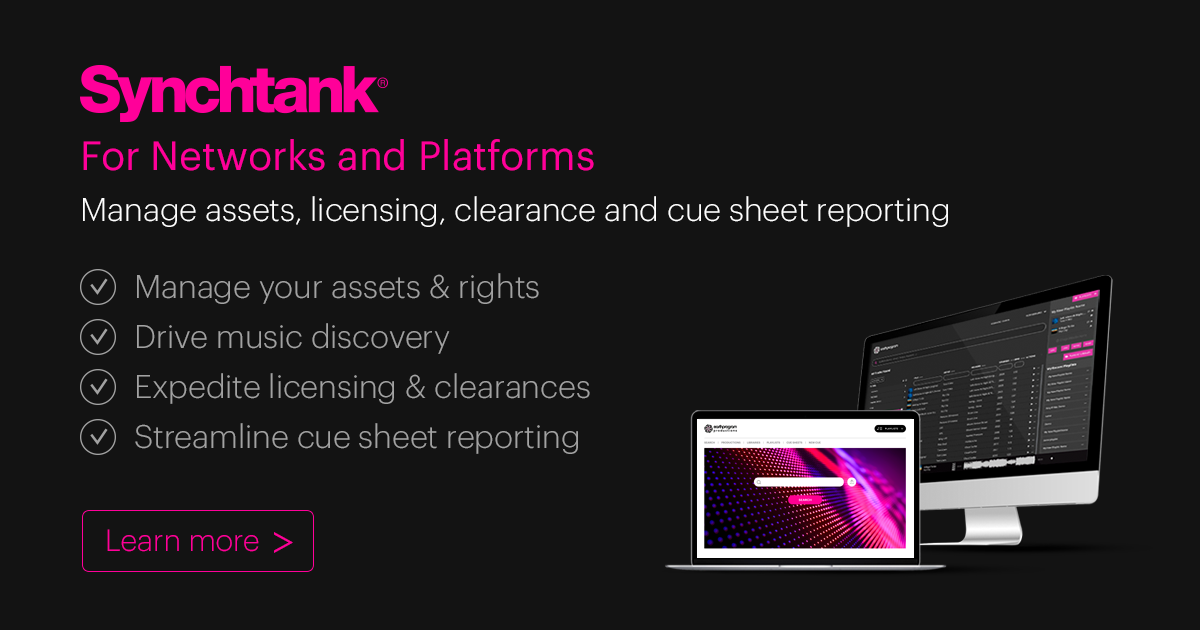Inefficient cue sheet administration is a huge legacy problem for the music industry, but major steps are being taken to modernise the process for the digital age. Eamonn Forde examines the progress so far.
Back in May, drawing on our Drowning in Data report, we looked at the multiple complications surrounding cue sheets as more and more music get licensed more and more into more and more TV shows and movies. As licensing grows, so to grow the problems associated with cue sheets.
“Film and television royalties present a unique set of challenges with regard to registration and collection,” is how Janet Landrum, Synchtank’s royalties specialist, put it at the time. “The possibility of registration errors, collection problems and missed money is much more prevalent in this medium.”
With a film possibly using hundreds of different cue titles, the margin for error can become significant and, if music is not registered properly or if a cue sheet is not filled out correctly, money is not necessarily finding its way back to the rightful owners and creators.
This is clearly a huge legacy problem for the industry, but equally huge steps are finally being taken towards resolving things here.
The primary concern – and one that directly parallels with all the headaches around metadata in streaming – is that this has been an analogue problem that increasingly and loudly draws attention to its own anachronistic standing in a digital world.
“Cue sheets essentially still exist just as pieces of paper that people shuffle around between each other,” says Alex Batterbee, senior director of global admin at Sony Music Publishing and the co-chair (publisher) at the Society Publisher Forum, which is playing a pivotal role in trying to resolve things here. “These days they tend to be PDFs, so that’s a step forward – but they’re certainly not data [i.e. stored and shared digitally].”
“Cue sheets essentially still exist just as pieces of paper that people shuffle around between each other.”
– Alex Batterbee, Sony Music Publishing
It all appears to be an unnecessarily complex process that is fraught with problems and that opens itself up to mistakes being made and errors being logged.
“What societies do, individually in each country within their own separated systems, is match the registered works they get from publishers to the hundreds of works that appear on each cue sheet and try and work out who’s controlling which song,” Batterbee explains. “And that’s all done basically manually because the piece of paper that comes from the film production company is effectively a sheet of paper with some writing on it.”
With TV and film licensing now increasingly global from the off as platforms like Netflix, Apple TV+, Disney and Amazon Prime Video extend their reach, the inherent problems with cue sheets will only multiply.
“When shows are syndicated or distributed to other territories, many times the cue sheets are redone to accommodate the platform or worksheet that broadcaster is using,” explains Michael Lau, president of the NY chapter of the Association of Independent Music Publishers and operations committee member of the Mechanical Licensing Collective. “Many times the titles are abbreviated and information is not accurately transferred.”
The industry has long been aware of all of these concerns and it appears that solutions are finally being worked towards, with the Society Publisher Forum – a joint initiative of CISAC, ICMP and IMPA (as well as being supported by AIMP and IMPF) – launching a new set of standards and rules for cue sheets in November 2020.
By harmonising things here, the Society Publisher Forum argued it will “make life simpler and more efficient for all actors using cue sheets”. It added, “The common goal is to ensure a standardised flow of data between publishers, societies and producers, and thus improve the flow of revenue back to the creators and rights holders.”
“The common goal is to ensure a standardised flow of data between publishers, societies and producers, and thus improve the flow of revenue back to the creators and rights holders.”
– Society Publisher Forum
This was followed in September of this year by the announcement of a new standardised template, the Music in Commercials Sheet. “It is designed to be used worldwide by TV and radio broadcasters, Collective Management Organisations, publishers and individual composers and songwriters,” explains CISAC.
“Ensuring that music used in commercials is correctly identified and remunerated is a challenge for creators, societies, and publishers,” says the announcement. “With many parties involved in the life cycle of the commercial, working across national borders, the metadata used can often be lost. Differing reporting formats and languages can also hinder the flow of information, to the detriment of music creators.”
Gadi Oron, CISAC’s director general, naturally applauded its arrival. “The new cue-sheet format for music in commercials better identifies creators’ music as it is used, and, as a result, ensures composers and songwriters are remunerated faster,” he said on its launch.
“Metadata is the alphabet of music,” added John Phelan, the director general of ICMP. “This cue sheet makes that alphabet legible, comprehensible and transferable for composers, publishers, users, broadcasters, administrators no matter where they are based. ICMP applauds all at the SPF for their work and extends its full support to the implementation of this project globally.
Those working in this area for many years – and who have found themselves having to repeatedly navigate the same (avoidable) problems – have long been calling for templated and standardised solutions that could eradicate the legacy issues of a paper-based system.
“Conflicting cue sheets are a problem and getting hold of cue sheets is a problem,” says Batterbee. “One of the things we want to do is essentially systematise the flow of that data from the producer all the way through to the society and the publisher and the writers who are involved so that everybody has access to that as data, as opposed to a flat piece of paper.”
He says the lofty goals of the Society Publisher Forum have to move in phases. Now that the standards have been launched, the next challenge is to create an electronic format to accommodate them.
“The next steps are to turn that into an electronic data exchange format, which then allows us to make changes with authority.”
– Alex Batterbee, Sony Music Publishing
“The next steps are to turn that into an electronic data exchange format, which then allows us to make changes with authority,” he continues. “Instead of creating a database, we’re looking to create something where we can exchange that data between us with updates and, if possible, some sort of data interchange format that embeds within it the changes that have been made to the cue sheet, because they’re not happening all the time; but when they happen, it’s important that everybody knows they have the latest version.”
To have the intended benefits, the measures and templates tabled by the Society Publisher Forum must be adopted internationally.
“It’s a global world,” says Batterbee. “You turn on Netflix and you see French, Korean and German programmes; therefore whatever requirements they have in their cue sheet apply across the world. We want one cue sheet for each individual production, or variation of that production. We don’t want a million different cue sheets for each production – which is where we are today.”
And therein lies the rub. For a solution that will, ultimately, benefit everyone, everyone has to sign up to it. No one, of course, expects a widespread problem to be solved overnight and thereafter everything moves seamlessly and smoothly forward.
“In terms of incentivising, I think everybody we’ve spoken to can see the benefit,” says Batterbee of the collective will for change here and the need to leave the archaic way of doing things in the past. “Producing pieces of paper and shifting them around the world is just really inefficient for everybody.”
Lau is optimistic that the processes currently being put in motion here can deliver.
“I think it is very realistic,” he says. “It just takes acceptance and adoption.” He fully believes the move from the analogue world of paper reporting to a new one where everything is digital will be the catalyst for this much-needed change. “Technology is the answer,” he says. “Period.”
“Technology is the answer. Period.”
– Michael Lau, AIMP
While technology will help solve many of these problems, there still needs to be humans inputting the data at the start (albeit in a templated manner).
We are not at a stage where things can be fully automated. Shazam-style audio fingerprinting technology will only help here to a certain point because of how music can be chopped or contorted into new shapes in an advert, TV show or film.
“We have music recognition technology companies involved in this conversation and they recognise that they need to store the results of their monitoring in a data format,” says Batterbee. “And where music recognition technology fails is because somebody slowed the music down or they adjusted it slightly for the dialogue, or the dialogue mixes in with the music. So the music recognition technology is confused. You also have the situation where certain composers reuse themes from previous scores that they’ve written.”
He continues, “Music recognition technology has great potential for catching one-off magazine shows that have a bit of music in or local content production. But that information then needs to be recorded. So this format is for that as well. It’s a way of sharing information and allowing for the inadequacies of music recognition technology, which are not great, but they are there. They can only recognise what you’ve given them to recognise.”
He says that the long-term commercial upsides here are both obvious and significant, with money held in the black box finally being released. “It’s about freeing up existing money, but it’s also about recognising music being used where today nobody has the time to recognise that music being used,” he proposes.
The moves here are necessary and pressing, but they have to be addressed carefully and stealthily. Rushing things will only risk making mistakes that could derail everything further down the line.
Batterbee says this will all come about in the near future as opposed to the immediate future – and that the industry has to be realistic about the speed of change that is possible here.
“I think that we are looking at probably a two-year cycle to get the electric format agreed and out there and fulfilling all the business needs the people have, as we originally designed it,” he says. “Then it’s going to be an ongoing process of iteration as needs develop.
He concludes, “It’s about a long-term plan to solve something that’s been a perennial problem.”
For more information about the new standards, visit www.societypublisherforum.net


1 comment
[…] This article originally appeared on synchtank.com. […]